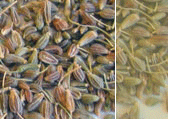ANISE IN FOOD & DRINK
Aniseed has a wide range of culinary
applications, both sweet and savory. In the Middle
East and India, anise is used in soups and stews, and various
cuisines use anise in seasoning blends such as curry, hoisin,
sausage and pepperoni seasonings. It is also used to compliment
duck, pork or fish, either alone or sometimes in combination with
cinnamon and bay leaves. All above-ground parts of the young anise
plant can be eaten as a vegetable. The stems resemble those of
celery in texture and have a much milder licorice flavor than
the seeds.
Anise is also used whole or crushed in cakes,
cookies, pastries, sweet breads and candy. Examples include aniseed
balls (a favorite English sweet), Italian biscotti
and Springerle, a German cookie with an embossed
design which is traditionally anise-flavored.
Aniseed is also used in anise-flavored
liqueurs (such as raki, arak and ouzo). Along
with grande wormwood and florence fennel, geen anise is one of
the main herbs in the infamous liquor absinthe,
which rose to popularity in late 19th- and early 20th-century
France, particularly among Parisian artists and writers. Anise
is also used in less potent beverages, such as root beer.
|





